What to do if spark doesn't jump a 7/16 in. gap on Mercury Outboard Motor?
- RRobert FoxJul 26, 2025
If the spark doesn't jump a 7/16 in. (11.11 mm) gap when testing all CDMs at cranking with a spark gap tester, continue with Chart #2.
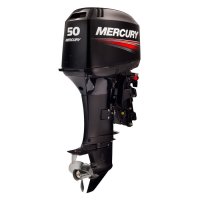
What to do if spark doesn't jump a 7/16 in. gap on Mercury Outboard Motor?
If the spark doesn't jump a 7/16 in. (11.11 mm) gap when testing all CDMs at cranking with a spark gap tester, continue with Chart #2.
| Horsepower | 40 hp |
|---|---|
| Starting System | Electric |
| Steering | Remote |
| Fuel Induction System | EFI (Electronic Fuel Injection) |
| Shaft Length | 20" |
| Full Throttle RPM Range | 6000 |
Details on how to register your product for warranty coverage with Mercury Marine.
Information on transferring the limited warranty to a subsequent purchaser.
Procedure for transferring the Product Protection Plan to a new owner.
Details on what is covered, duration, and conditions for the limited warranty.
Coverage details for corrosion protection on Mercury marine engines.
Explanation of services covered and not covered by the warranty.
Operator's duties for safe operation of the boat and outboard.
Instructions for reading the manual and understanding safe operation.
Warning about exceeding the boat's maximum horsepower rating.
Guidance for operating high-speed or performance boats.
Requirements for remote control start-in-neutral protection.
Importance of using self-locking nuts for steering link rods.
Function and operation of the engine's lanyard stop switch.
Safety precautions for preventing injury to swimmers.
Specific safety advice for pontoon and deck boat passengers.
Guidance on using elevated fishing seats safely.
Hazards associated with operating over waves and wakes.
Precautions for driving in shallow water or suspect areas.
Specific safety advice for hand-tilled outboard operation.
Installation requirements for outboards with clamp screws.
Information and warnings about carbon monoxide poisoning.
Advice on choosing and installing genuine Mercury accessories.
General recommendations for safe and enjoyable boating.
Instructions for recording the outboard's serial number.
Technical specifications for 40 and 50 HP models.
Diagrams identifying various parts of the outboard.
Procedures and safety warnings for mounting the outboard.
Specific installation methods for models with clamp screws.
Guidance on selecting the correct propeller for performance.
Proper procedures for trailering a boat with the outboard.
Safety instructions for transporting portable fuel tanks.
Guidelines for using appropriate gasoline and avoiding damage.
EPA requirement for low permeation fuel hoses in the US.
Recommended oils and specifications for the outboard engine.
Mixing ratios for gasoline and oil for break-in and operation.
Procedures for mixing fuel and oil for portable and built-in tanks.
Steps for checking and filling the engine's oil injection system.
Safety precautions and procedures for filling fuel tanks.
Overview of components and functions of remote control systems.
Description of the warning horn system for electric start engines.
Description of the warning horn system for manual start engines.
Explanation of the engine's over-speed protection feature.
Operation and safety for the manual tilt system.
How to use the power trim and tilt feature for outboard adjustment.
Using the auxiliary tilt switch with the power trim system.
Adjusting the throttle grip friction for speed control.
Adjusting steering friction for safe boat control.
Adjusting the trim tab to compensate for steering torque.
Essential checks before starting the outboard engine.
Precautions for operating the outboard in freezing conditions.
Recommended flushing and care procedures for saltwater use.
Considerations for operating the outboard at high altitudes.
Critical steps for breaking in a new outboard engine.
Step-by-step guide to starting electric start models.
Step-by-step guide to starting tiller handle models.
Correct procedures for shifting gears at various engine speeds.
Procedures for safely stopping the outboard engine.
Procedure for starting electric models using emergency rope.
Procedure for starting manual models using emergency rope.
General advice for keeping the outboard in good operating condition.
Information on EPA certification and emissions control.
Scheduled maintenance tasks based on usage intervals.
Procedure for flushing the cooling system after use.
Tips for cleaning and protecting the outboard's exterior finish.
Steps for removing and reinstalling the top engine cowl.
How to inspect the battery for proper engine starting capability.
Safety and service procedures for the outboard's fuel system.
Correct installation and safety of steering link rod fasteners.
Procedure for replacing fuses in electric start models.
Inspection and replacement of corrosion control anodes.
Step-by-step guide for replacing the outboard propeller.
How to inspect, gap, and replace spark plugs.
Locations and procedures for lubricating various outboard components.
Procedure for checking and refilling power trim fluid.
Steps for draining, refilling, and checking gearcase lubricant.
Procedures for preparing the outboard for seasonal storage.
Methods to protect external parts from rust and corrosion.
Steps for protecting internal engine parts during storage.
Gearcase lubricant procedures before storage.
Correct orientation for storing the outboard to prevent damage.
Guidelines for storing the boat battery during the off-season.
Possible causes and solutions when the engine starter fails.
Common reasons and troubleshooting steps for a non-starting engine.
Troubleshooting issues causing the engine to run unevenly.
Identifying causes for reduced engine performance.
Diagnosing problems with a battery that fails to retain charge.
Importance of using authorized dealers for service and repairs.
How to find service when away from your local dealer.
Directing inquiries for replacement parts and accessories.
Steps to take for resolving questions or problems with the product.
Contact information for Mercury Marine service offices worldwide.
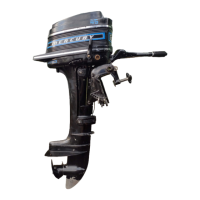
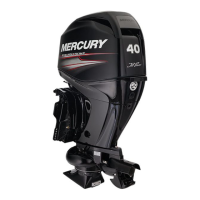

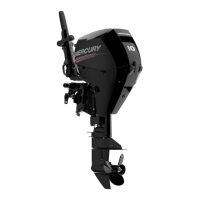

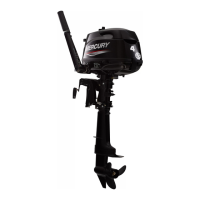


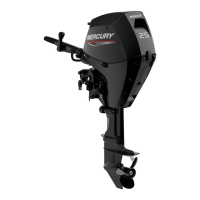

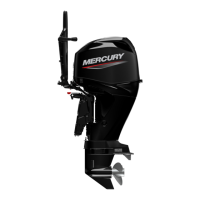
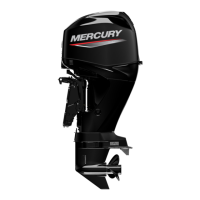
